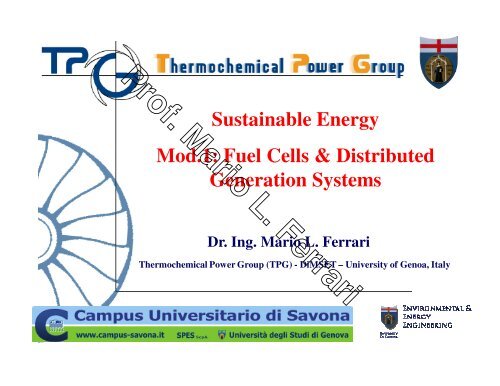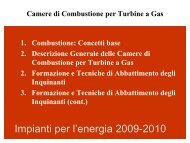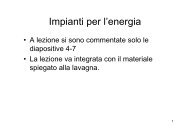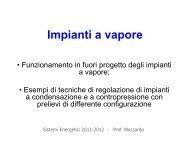Lesson XIII - Hydrogen (production, distribution and storage) - TPG
Lesson XIII - Hydrogen (production, distribution and storage) - TPG
Lesson XIII - Hydrogen (production, distribution and storage) - TPG
Create successful ePaper yourself
Turn your PDF publications into a flip-book with our unique Google optimized e-Paper software.
Sustainable Energy<br />
Mod.1: Fuel Cells & Distributed<br />
Generation Systems<br />
Dr. Ing. Mario L. Ferrari<br />
Thermochemical Power Group (<strong>TPG</strong>) - DiMSET – University of Genoa, Italy<br />
A.A. 2011-2012
<strong>Lesson</strong> <strong>XIII</strong><br />
<strong>Lesson</strong> <strong>XIII</strong>: hydrogen (<strong>production</strong>,<br />
<strong>distribution</strong> <strong>and</strong> <strong>storage</strong>)<br />
A.A. 2011-2012
The <strong>Hydrogen</strong> Economy (1/2)<br />
<strong>Lesson</strong> <strong>XIII</strong><br />
October 2002<br />
Very senior representatives<br />
from major European<br />
automotive <strong>and</strong> energy<br />
companies, SME, research<br />
centres, utilities, policy<br />
makers, <strong>and</strong> users<br />
associations advise on<br />
prospects for economic<br />
impact of moving towards a<br />
sustainable energy economy<br />
based on hydrogen <strong>and</strong><br />
electricity as carriers, using<br />
fuel cells as efficient energy<br />
converters.<br />
A.A. 2011-2012
The <strong>Hydrogen</strong> Economy (2/2)<br />
<strong>Lesson</strong> <strong>XIII</strong><br />
A.A. 2011-2012
<strong>Hydrogen</strong> LHV<br />
A.A. 2011-2012
<strong>Hydrogen</strong> Production (1/7)<br />
<strong>Lesson</strong> <strong>XIII</strong><br />
Fossil<br />
Renewable<br />
Sources<br />
Oil<br />
Natural gas<br />
Coal<br />
Nuclear<br />
Wind, PV<br />
Solar<br />
Biomass<br />
ZERO EMISSION<br />
CONVERSION<br />
Gasification<br />
Thermochemical<br />
processes<br />
Electrolysis<br />
Thermochemical<br />
processes<br />
Gasification<br />
<strong>Hydrogen</strong><br />
H 2 pipes<br />
H 2 <strong>storage</strong><br />
<strong>and</strong> delivery<br />
UTILIZATION<br />
Distributed<br />
power<br />
generation<br />
Residential<br />
Industry<br />
Transport<br />
Other<br />
CO 2 sequestration<br />
A.A. 2011-2012
<strong>Hydrogen</strong> Production (2/7)<br />
<strong>Lesson</strong> <strong>XIII</strong><br />
A.A. 2011-2012
<strong>Lesson</strong> <strong>XIII</strong><br />
<strong>Hydrogen</strong> Production (3/7)<br />
<strong>Hydrogen</strong> from coal<br />
Reactions for hydrogen generation from coal:<br />
gasification<br />
Different types of gasifiers: moving bed (450-500°C), fluidized bed (800-<br />
1000°C) <strong>and</strong> entrained bed (1200-1400°C).<br />
Downstream of the gasifier: cleaning units.<br />
A.A. 2011-2012
<strong>Lesson</strong> <strong>XIII</strong><br />
<strong>Hydrogen</strong> Production (4/7)<br />
<strong>Hydrogen</strong> form hydrocarbons (1/2)<br />
Reactions for hydrogen generation through steam reforming from light<br />
hydrocarbons:<br />
Typical catalysts: Ni based composites or Mg oxides.<br />
Typical temperature: 800°C.<br />
A.A. 2011-2012
<strong>Lesson</strong> <strong>XIII</strong><br />
<strong>Hydrogen</strong> Production (5/7)<br />
<strong>Hydrogen</strong> form hydrocarbons (2/2)<br />
Reactions for hydrogen generation through partial oxidation:<br />
Methanol<br />
Petrol<br />
A.A. 2011-2012
<strong>Hydrogen</strong> Production (6/7)<br />
<strong>Lesson</strong> <strong>XIII</strong><br />
A.A. 2011-2012
<strong>Hydrogen</strong> Production (7/7)<br />
<strong>Lesson</strong> <strong>XIII</strong><br />
<strong>Hydrogen</strong> form Electrolysis<br />
Current technology: Low<br />
temperature electrolyers<br />
(efficiency: 65%)<br />
Technology under<br />
development: High temperature<br />
electrolyers - SOEC (efficiency:<br />
80%-85%)<br />
A.A. 2011-2012
<strong>Hydrogen</strong> Storage (1/10)<br />
<strong>Lesson</strong> <strong>XIII</strong><br />
• Existing technologies<br />
– compressed H 2 (p>700 bar)<br />
– liquid (or gel) H 2<br />
– glass microspheres filled with H 2<br />
– physical adsorption (carbon nanostructures, zeolithes,<br />
nanoporous materials)<br />
– metallic hydrides (simple <strong>and</strong> complex)<br />
– chemical <strong>storage</strong> (hydrides of ammonium, lithium, sodium,<br />
magnesium)<br />
Chemical reaction for H 2 <strong>production</strong>:<br />
» MgH 2 + 2 H 2 O = Mg (OH) 2 + 2H 2<br />
– reformable fuels (methane, methanol, ethanol, oil F76)<br />
A.A. 2011-2012
<strong>Hydrogen</strong> Storage (2/10)<br />
<strong>Lesson</strong> <strong>XIII</strong><br />
A.A. 2011-2012
<strong>Hydrogen</strong> Storage (3/10)<br />
<strong>Lesson</strong> <strong>XIII</strong><br />
A.A. 2011-2012
<strong>Hydrogen</strong> Storage (4/10)<br />
<strong>Lesson</strong> <strong>XIII</strong><br />
High pressure bottles:<br />
200-250 bar<br />
•As soon as possible 350 bar bottles will be available.<br />
•R&D activities regards 700 bar bottles.<br />
A.A. 2011-2012
<strong>Hydrogen</strong> Storage (5/10)<br />
<strong>Lesson</strong> <strong>XIII</strong><br />
Liquid <strong>storage</strong> at -253°C<br />
It is possible to store higher hydrogen quantities (at equal<br />
volume) in comparison with gas high pressure <strong>storage</strong><br />
(pressures are low: 2-3 bar). Thermal insulation problems<br />
are completely solved.<br />
An example comes from BMW 750h <strong>storage</strong> tank built in<br />
collaboration with LINDE.<br />
A.A. 2011-2012
<strong>Hydrogen</strong> Storage (6/10)<br />
<strong>Lesson</strong> <strong>XIII</strong><br />
A.A. 2011-2012
<strong>Hydrogen</strong> Storage (7/10)<br />
<strong>Lesson</strong> <strong>XIII</strong><br />
<strong>Hydrogen</strong> can be chemically alloyed to different metals or metal alloys<br />
generating hydride. These composites are able to trap hydrogen at<br />
relatively low pressure.<br />
<strong>Hydrogen</strong> enters into metal grid <strong>and</strong> goes to hold interstice spaces. A<br />
widespread hydride is LiH.<br />
A typical R&D issue for these systems is weight.<br />
On the other h<strong>and</strong> these systems are the best <strong>storage</strong> systems for safety.<br />
Now several R&D activities are under development for several kind of<br />
hydrides.<br />
A.A. 2011-2012
<strong>Hydrogen</strong> Storage (8/10)<br />
<strong>Lesson</strong> <strong>XIII</strong><br />
Size comparison for a tank necessary for 400 km range (4 kg of<br />
hydrogen) with the state-of-the-art <strong>storage</strong> technology:<br />
magnesium hydrides (Mg 2 NiH 4 ), lantanium hydrides (LaNi 5 H 6 ),<br />
cryogenic liquid of H 2 , H 2 at 200 bar (Source: C. Filiou, “An<br />
overview of the hydrogen solid <strong>storage</strong> solution”, European<br />
Commission, Joint Research Centre, Training Workshop<br />
Presentation, 2003).<br />
A.A. 2011-2012
<strong>Lesson</strong> <strong>XIII</strong><br />
<strong>Hydrogen</strong> Storage (9/10)<br />
Chemical <strong>storage</strong> as NaBH 4<br />
Catalitic reactor (packed bed)<br />
Johnson Matthey catalyst<br />
(3% 2 mm Ru on extrused graphite)<br />
NaBH4 + 2 H2O NaBO2 + 4 H2 + calore<br />
A.A. 2011-2012
<strong>Hydrogen</strong> Storage (10/10)<br />
Storage<br />
<strong>Lesson</strong> <strong>XIII</strong><br />
User<br />
A.A. 2011-2012
<strong>Hydrogen</strong> Distribution (1/3)<br />
<strong>Lesson</strong> <strong>XIII</strong><br />
COAL<br />
CARBONE<br />
H 2 O<br />
idrogeno H 2<br />
Heat<br />
acqua<br />
LH 2<br />
LH 2<br />
-252 °C<br />
1.3 bar<br />
LH 2<br />
LH 2<br />
calore<br />
CO 2<br />
Electricity elettricità<br />
60 bar<br />
-252 °C<br />
1.3 bar<br />
-252 °C<br />
CGH 2<br />
fino a 800 bar<br />
COAL<br />
CARBONE<br />
H 2 O<br />
acqua<br />
idrogeno H 2<br />
Heat calore<br />
LH 2<br />
LH 2<br />
-252 °C<br />
1.3 bar<br />
CO 2<br />
elettricità Electricity<br />
60 bar<br />
-252 °C<br />
1.3 bar<br />
LH 2<br />
LH 2<br />
-252 °C<br />
230 bar<br />
CGH 2 200 bar<br />
CGH 2<br />
400<br />
bar<br />
850 bar<br />
CGH 2<br />
CGH 2<br />
30 bar<br />
A.A. 2011-2012
<strong>Hydrogen</strong> Distribution (2/3)<br />
<strong>Lesson</strong> <strong>XIII</strong><br />
CARBONE<br />
CO 2<br />
COAL<br />
H 2 O<br />
acqua<br />
idrogeno H 2<br />
calore Heat<br />
Electricity elettricità<br />
60 bar<br />
LH 2<br />
LH 2<br />
-252 °C<br />
1.3 bar<br />
-252 °C<br />
1.3 bar<br />
LH 2<br />
LH 2<br />
-252 °C<br />
Idrogenodotto AP (75 bar)<br />
1.5 bar<br />
Idrogenodotto MP (20<br />
bar)<br />
Idrogenodotto BP<br />
(1.5 bar)<br />
400 bar 850 bar<br />
30 bar<br />
CGH 2<br />
CGH 2<br />
A.A. 2011-2012
<strong>Hydrogen</strong> Distribution (3/3)<br />
<strong>Lesson</strong> <strong>XIII</strong><br />
CRYOCOOLER<br />
LH 2<br />
-252<br />
°C<br />
+ _ CGH 2 a 30 bar<br />
CGH<br />
Water<br />
2<br />
ELECTROLIZER<br />
400<br />
bar<br />
850<br />
bar<br />
CGH<br />
2<br />
COAL<br />
CARB ONE<br />
H 2 O<br />
acqua<br />
idrogeno H 2<br />
calore<br />
Heat<br />
LH 2<br />
LH 2<br />
-252 °C<br />
1.3 bar<br />
LH 2<br />
LH 2<br />
CO 2<br />
Electricity<br />
elettricità<br />
60 bar<br />
-252 °C<br />
1.3 bar<br />
GAS NATURALE<br />
ACQUA<br />
SMR<br />
CGH 2 a 15 bar<br />
CGH 2<br />
400<br />
bar<br />
850 bar<br />
CGH 2<br />
A.A. 2011-2012
<strong>Hydrogen</strong> Storage <strong>and</strong> Distribution<br />
<strong>Lesson</strong> <strong>XIII</strong><br />
A.A. 2011-2012












